Menu
Download the accompanying materials to this lesson plan - sign up here
Resources and materials for ESL Kids teachers
This lesson really helps students to learn the seasons of the year and words associated with each season.
See our "Warm Up & Wrap Up" page.
1. Introduce the vocab: the four seasons
Before class prepare four pieces of paper with the following written on:
Four students are going to read these and draw the pictures on the board. Alternatively, whisper the instructions into your students’ ears or show them flashcards to copy.
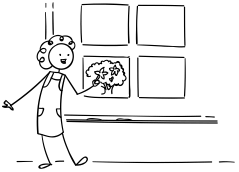 In class, draw 4 large squares in the board. Invite a volunteer student to come up to the board and draw the first picture inside the first of the 4 squares. As the student is drawing, get the other students to guess what is in the picture (e.g. "What’s this?", "It’s a tree"). Do the same with other students for the remaining three pictures.
In class, draw 4 large squares in the board. Invite a volunteer student to come up to the board and draw the first picture inside the first of the 4 squares. As the student is drawing, get the other students to guess what is in the picture (e.g. "What’s this?", "It’s a tree"). Do the same with other students for the remaining three pictures.
Once all 4 pictures have been drawn, point at the first picture and ask "When does the tree look like this?". Elicit / Teach "Spring" and write the word under the picture. Do the same for all for pictures and chorus each season word 4 times.
2. Play "Seasons Word Association Draw"
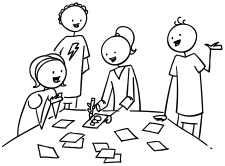 Divide the class into teams (of 3 or 4 students). Give each team one pen and lots small pieces of colored paper (e.g. Team A has only red paper, Team B has only blue paper, etc.). This is very important as you will be giving scores to each team based on the amount of pictures they have drawn.
Divide the class into teams (of 3 or 4 students). Give each team one pen and lots small pieces of colored paper (e.g. Team A has only red paper, Team B has only blue paper, etc.). This is very important as you will be giving scores to each team based on the amount of pictures they have drawn.
Next, put 4 boxes in the 4 corners of your classroom. Each box should be labelled with a season (e.g. one box will have "Spring” written on it, another "Summer", etc.).
Now model the activity: take one piece of paper and draw an ice cream. Elicit the word and then say "Where should I put this?" and gesture towards the 4 boxes. After receiving a reply for summer, go to the summer box and drop the paper in it. Next do the same for spring (a flower), autumn (a pumpkin) and winter (a woolly hat).
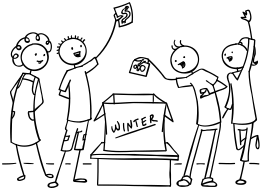 Finally drop a prize into each box (e.g. some candy or stickers, etc.) and explain that the team with the most (correct) pictures in each box will win the prize. Place a timer in view of everyone and set 5 minutes. Then say "Go!".
Finally drop a prize into each box (e.g. some candy or stickers, etc.) and explain that the team with the most (correct) pictures in each box will win the prize. Place a timer in view of everyone and set 5 minutes. Then say "Go!".
As each team has only one pen they will have to work together to come up with ideas and draw them. Then one player will have to rush to a box and drop the picture into it. Teams will probably find summer and winter easy but may need some prompting from you for spring and autumn. As they are drawing, walk around and ask questions (e.g. What is that?) and elicit / teach vocab. Make sure someone draws some key vocab from the song that will be sung later in the lesson (a picnic, beach, snow).
When the timer goes off get everyone to stop. You are going to count the number of papers each team has in each box – but you are going to be really strict! Throw out any badly drawn pictures which you can’t guess what they are and any pictures that are wrong or are not season specific. Elicit what each picture is when you hold it up. Count the scores and write them on the board. Then tell the class that they have an additional 5 minutes to finish but must not draw any pictures that other teams have drawn. Set the timer for a further 5 minutes and start.
When the timer goes off, be strict again about which pictures earn points and finally give out the prizes to the teams with the most points.
3. Do "Season objects writing" activity
Your students are going to write the words for the pictures they have just drawn, so this is a great activity if your students are at a high enough level to write words (even with spelling mistakes). If not (for younger students), skip this activity and go on to point 4. Take the boxes with pictures inside and give the pictures out randomly to each group. Model by holding up one of the pictures (e.g. a flower) and elicit the word. Then turn over the piece of paper and write "flower" on the back.
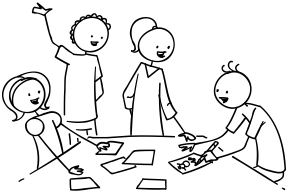 Give a time limit (say 5 minutes) and get each group to write words on the back of as many pictures as they can, using the one pen (again, so they will have to work as a team). If a team does not know the word, they can send one person up to the teacher with the picture to ask what it is – but the teacher will only say the word and will refuse to spell it – the students will have to try their best to spell each word.
Give a time limit (say 5 minutes) and get each group to write words on the back of as many pictures as they can, using the one pen (again, so they will have to work as a team). If a team does not know the word, they can send one person up to the teacher with the picture to ask what it is – but the teacher will only say the word and will refuse to spell it – the students will have to try their best to spell each word.
When the timer goes off, tell everyone to stop writing. On the board draw two intersecting lines so the board is divided into four equal squares. Write a season in each of the squares. Go around the class asking for the words they have written and write the words on the board – for each correct spelling the team wins a point (also, make sure they correct their spelling mistakes on the back of the pictures). At the end total up the points and award a prize to the winning team.
4. Play "Season Bingo"
Keep the same groups together and the pictures that they have drawn. Get each team to deal out the pictures so that each student is holding the same number of pictures. The class is going to play "Season Bingo" with the pictures. The teacher says a season and a word (e.g. "summer – ice cream") and any students holding that picture can put it in the middle of their table. Keep going until one student has discarded his/her last card and shouted "Bingo!". Play a few rounds for fun.
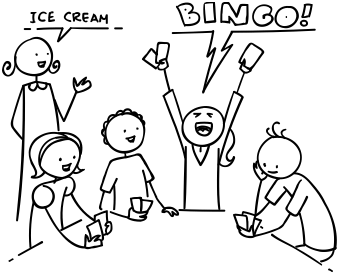
5. Sing "The Seasons Song"
Before class, print off the song poster for The Seasons Song. Put the song poster on the board and elicit the seasons and the activities on it. Then get everyone to stand up and follow you doing the actions and singing (as described below in Gestures for "The Seasons Song"). Play the song through 2 or 3 times.
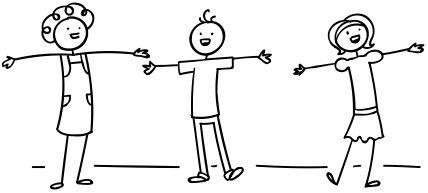
Lyrics for "The Seasons Song"
Chorus:
Spring, Summer, Autumn, Winter.
Spring, Summer, Autumn, Winter.
Verse 1:
In the spring, in the spring,
It's nice and warm, nice and warm,
In the spring, in the spring,
It's nice and warm, nice and warm,
Let's go for a picnic!
Chorus
Verse 2:
In the summer, in the summer,
It's very hot, very hot,
In the summer, in the summer,
It's very hot, very hot,
Let's go to the beach!
Chorus
Verse 3:
In the autumn, in the autumn,
It's nice and cool, nice and cool,
In the autumn, in the autumn,
It's nice and cool, nice and cool,
Let's go for a walk!
Chorus
Verse 4:
In the winter, in the winter,
It's really cold, really cold,
In the winter, in the winter,
It's really cold, really cold,
Let's play with the snow!
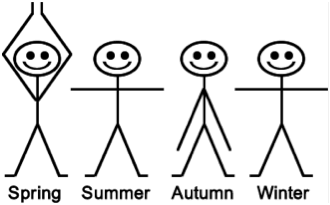
Gestures for "The Seasons Song"
We'll use some fun gestures with this song:
- during the chorus do the following gestures, standing with legs apart (see picture):
- during the verses do the following gestures:
We also have a video that you can stream in class to sing along with (Internet connection required):
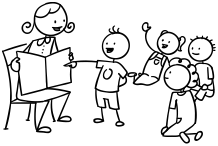 6. Read classroom reader
6. Read classroom reader
Let's follow the song with a reader which uses vocabulary from the song. We have 2 different classroom readers for you to choose from:
Four Seasons (better for lower levels / younger kids):
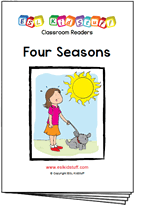 Before class, download and print off the reader "Four Seasons" from our website. As you go through each page, point to the pictures and elicit the seasons and climates and also ask what activity we can do, for example:
Before class, download and print off the reader "Four Seasons" from our website. As you go through each page, point to the pictures and elicit the seasons and climates and also ask what activity we can do, for example:
Teacher: (pointing at the picture on page 1) Look at the girl. What's this with the girl (pointing at the dog)?
Students: A dog!
Teacher: Yes, it's her pet dog! Hello! So, what season do you think it is?
Students: Spring!
Teacher: Yes, good job, it's spring! And is it cold in spring?
Students: No, it's warm.
Teacher: Ok, let's check (reading on page 1) "It’s spring. It’s nice and warm". Well done! (Reading again) "What shall we do?". Well, it's nice and warm. What do you think they should do in spring?
Students: Go for a picnic!
Teacher: Let's see (turning the page and reading) "Let's go for a picnic!". Yes, that's right. Look, what are they having for their picnic?
etc.
Get the students really involved in the story by asking lots of questions about the different things in the pictures. When you get to the end, find out which season each student likes best, for example:
Teacher: (reading on pages 9 and 10) "Which season do you like best?". (Pointing at the seasons pictures) Which season do you like best Miki?
Miki: Um ... summer!
Teacher: The summer. Yes, I like summer too. What do you do in summer, Miki?
Students: I go to the beach.
Teacher: Yes, it's hot in the summer, isn't it? So the beach is a good place to go. How about you, Tomas? Which season do you like best?
Students: Winter!
etc.
After reading the story, give out a reader worksheet to each student and have everyone match the seasons to the actions. Then go through the answers as a class.
---
Alternatively, watch our video version of the reader (Internet connection required):
Silly Willy's Seasons (better for higher levels / older kids):
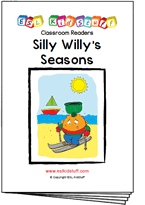 Before class, download and print off the reader "Silly Willy's Seasons" from our website. As you go through each page, point to the pictures and elicit the seasons and talk about what Silly Willy is doing, for example:
Before class, download and print off the reader "Silly Willy's Seasons" from our website. As you go through each page, point to the pictures and elicit the seasons and talk about what Silly Willy is doing, for example:
Teacher: (pointing at the picture on page 4) Look at Silly Willy! What is he doing?
Students: He's going for a walk!
Teacher: Yes, that's right! And how is the weather?
Students: It's sunny!
Teacher: Yes, good job! And what season do you think it is?
Students: Spring?
Teacher: Ok, let's check (reading on page 5) "One spring day, Silly Willy went outside. It was warm and sunny. There were lots of flowers and rabbits were playing in the fields.". Good job, it is spring!
Get the students really involved in the story by asking lots of questions about the weather during different months and activities they do (and don't do) in their country, for example:
Teacher: (reading on page 5) "What did Silly Willy do? He tried to build a snowman!". Build a snowman in spring? Do you build snowmen in spring?
Students: No!
Teacher: Of course not. It's too warm for snow in spring. When do you build snowmen?
Students: In winter!
Teacher: Yes, that's right. So what do you do in spring?
Students: We go for picnics.
etc.
After reading the story, give out a reader worksheet to each student and have everyone answer the questions. Then go through the answers as a class.
---
Alternatively, watch our video version of the reader (Internet connection required):
7. Do the "Seasons Clock" craft
This is a great craft which you can hang on the classroom walls and update each season or even each month. Before class there are a few things you will need to prepare:
Put the class into groups of 3 or 4 and give out the materials to make the season clocks. Start off by getting everybody to draw 4 lines from the center of the circle to the outside, so that you create 4 different areas (one for each season). Write the word for each season in each segment. If you have taught months, get everybody to write the months in order around the edge of the clock, with 3 months in each segment (you can just use the first letters of each month), so that it looks like the image below:
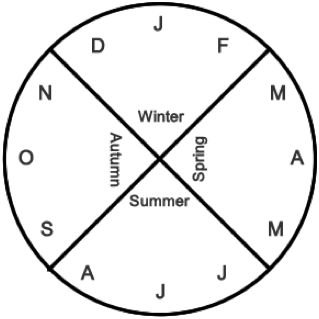
Now comes the fun part – everyone is going to get creative and decorate the clock – cutting out flower shapes and gluing onto spring, cutting out leaf shapes and gluing onto autumn, making a beach scene in summer (put glue on the paper and then sprinkle over the sand/glitter to make the beach – use blue colored pens or paint for the sea) and gluing cotton wool for snow in winter. Let everyone add extras, e.g. a big sun in summer, seasonal clothing, etc.
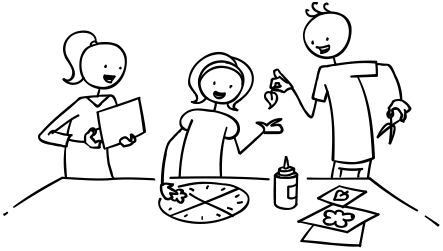
When everyone has finished, stick the crafts onto the wall and give each team a pin (or something sticky, like blue tak) to place in the season (or month) that it is now.
In future lessons you can refer back to the clocks and have your students move the pin as the seasons (and months) change.
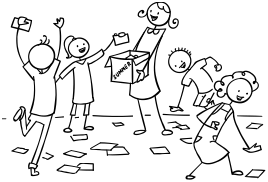 8. Play "Find the Season Pictures"
8. Play "Find the Season Pictures"
To end the lesson, we’ll have some fun with the pictures the students drew in point 2. Clear all the desks and chairs to the edge of the room. Collect up all of the pictures and then randomly scatter them around the room. Next, pick the Summer box from point 2, and say "Ok, everyone. Find all the summer pictures and put them in the box, Ready … Go!".
Everyone rushes around picking up pictures and placing them in the summer box. Then do the same for the other seasons.
1. Assign Homework: "Four Seasons" worksheet.
2. Wrap up the lesson with some ideas from our "Warm Up & Wrap Up" page.
 Found a mistake?
Found a mistake?
Please let us know
Full access to all resources on ESL KidStuff including lesson plans, flashcards, worksheets, craft sheets,
song downloads, classroom readers, flashcards app and songs app.